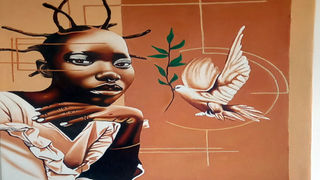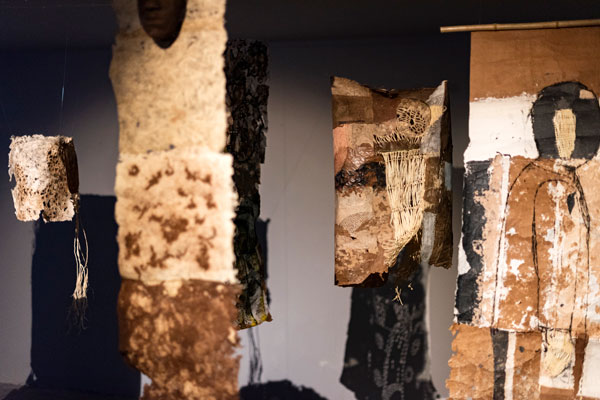
Peaceful Gaze by Fridah Ijai.
|National
Prime
Female artists deliver messages on canvas
What you need to know:
- The women were part of the three-week group exhibition dubbed “Surfacing” that is elevating 12 emerging women artists based in Khartoum (Sudan), Nairobi (Kenya), and Kampala.
- The aim is not only to empower and promote talented East African women artists to a broader audience, but also to spotlight some of the incredible female talents from East Africa that are on the verge of success,” Thadde Tewa, the curator of the exhibition
A painting made of mixed medium-acrylic on canvas and repurposed non-woven bags headlined an exhibition that ran its course at Xenson Art Space in Kampala on June 14.
The exhibition that had been running since May 20, featured 27 paintings that explored diverse themes and styles such as nature and landscapes, portraiture, figurative, women’s rights and empowerment, social behaviour, and identity.
The standout painting titled When We Were Young is the work of Kenyan artist Irene Katumbi.
It depicts five women all dressed in pink and light purple dresses with long African cornrows hairstyles against a green background.
The green background represents hope even as the women move into a world of newness.

“When we were Young” by Irene Katumbi
Katumbi told Monitor that the painting shows the last photo five women took before embarking on different journeys in their lives. It’s a photo taken when the women were in their youth.
They were, she added, bold, confident and assertive. They were also bound together by friendship and a familiar culture.
Katumbi’s other painting titled Conversations in the Garden shows three women all dressed in pink and light purple dresses with long African cornrows hairstyles on a pink background and green plants.
The three women are depicted as having private conversations in a family gathering. It showcases empowerment, feminine energy, and unity.
“Sworn in unity, they choose to fight for each other even as they discuss the various challenges around their culture and community. In togetherness, we win,” Katumbi revealed, adding, “This piece shows feminine energy flowing through the ladies despite the cultures and challenges they exist in. These conversations keep them going and give them positivity to fight another day.”
Katumbi’s focus on the eyes is very intentional, mostly to capture the viewers and draw them into the artwork.
She strongly believes through the eyes, the soul of her imaginary subjects speaks. Long natural hair is to portray freedom and self-expression.
By using thick layers of acrylic on canvas, Katumbi invites the viewer into her artistic process. To her, the eyes signify hope, although sometimes they give a more profound yearning for freedom from self and the surrounding.
And they were 12
Katumbi was part of the three-week group exhibition “Surfacing” that is elevating 12 emerging women artists based in Khartoum (Sudan), Nairobi (Kenya), and Kampala.
The other artists who graced the exhibition were Babirye Erinah Fridah (Uganda), Doreen Mueni (Kenya), Fridah Ijai (Kenya), Nadia Wamunyu (Kenya), Maab Tajuldeen (Sudan), Reem Aljeally (Sudan), Sandra Wauye (Kenya), Usra Hamza (Sudan), Sheila Bayley (Kenya), Taabu Munyoki (Kenya), and Eva Lamanda (Kenya).
Ijai had two paintings titled In My Thoughts and Peaceful Gaze. The latter depicts a woman resting her chin on her left arm with a hair threading hairstyle and a bird flying with a plant in its beak.
“The purpose of the painting is to appreciate the beautiful and peaceful Africa,” Ijai said of Peaceful Gaze.
About In My Thoughts, she says: “I literally poured what goes on in my head on canvas. Two forces that are in constant war with each other—yin and yang, light and dark, feminine energy and masculine energy, positive and negative thoughts all in the same environment. Apparently this is balance.”
Aljeally’s single painting had the distinction of having the longest title—I Let Go and I Can Breathe Again Except That There is no Air.
The length of the title notwithstanding, it depicts a person seated with a cat and flowerpot on the side.
“It’s a simple narration of feelings of familiarity, defeat, or acceptance to what is brought about,” Aljeally said of her work, adding, “The figure is in a very comfortable and known environment where she’s able to be her true self and allow her emotions to fully surface.”
Aljeally draws her inspiration from personal reflection, observations, and curiosity. In her painting, the characters reveal mixed emotions of familiarity, vulnerability, defeat, or acceptance of reality, which is uncertain.
By incorporating plants and cats in her compositions, she reveals high self-esteem, comfort, optimism, and compassion.
“My artistic approach has been focused on paintings that depict the solace black femmes find in solitude or with each other as they softly ask the audience to consider what femmes have to navigate in order to occupy space,” she told Monitor.
Babirye had three mixed artworks—Wild Flowers; Through the Palms; and Untitled. Symbolic meaning, and the physical and scientific characteristics of plants are explored to give meaning to her work. Facial features are used to humanise plants in her work with the sole purpose of creating a closer link between people and nature.
Mueni had three portrait paintings—Afro-neuro face 2; Afro-Neuro Face 6; and Serenity. Her work combines portraiture, abstract expressionism, and neurographic patterns.
Using oil and acrylic on canvas, and the chiaroscuro technique (use of bold contrasts between light and dark), she depicts the beauty, elegance, and strength of her subjects and women in general.
Other artists
Wamunyu tucked three paintings under her belt. They depict a woman in a swimsuit and are titled Black is Gold I; Black is Gold II; and Black is Gold III.
Using her half-Nubian female body as a way to express her emotions, insecurities, Wamunyu articulates past experiences as a young African woman. From a broader perspective, these works address a serious identity crisis among most young African women who are not confident in their skin colour or black bodies.
Tajuldeen had two paintings—Memories Leaking; and Welcome to My Imagination. The vibrant colour contrast in her palette and the flowers in her pieces represent her hopes and aspirations for her people.
Wauye had one painting titled Don’t Hide. It depicts two people in close embrace. Wauye’s paintings mostly depict human figures of African descent that reveal reality and tales of personal struggles, inner turmoil, triumph, vulnerability, and survival.

“Time Lapse II” by Usra Hamza
Usra had three portrait paintings—Awaiting; Time Lapse II; and Time Lapse. She conveys her thoughts as portraiture, figurative, and abstract compositions.
Bayley had one painting titled Heading On. It depicts two huge human figure facing each other with several other human figures and patterns in different colours in the artwork.
Characterised by a distinctive palette and a compelling storytelling approach, Bayley draws her inspiration from her background in psychology, memory, identity, fashion, nature, architecture, and cultural diversity.
Combining black figurative styles, silhouettes, symbolism, and design elements, she develops unique narratives that represent her journey towards self-awareness, self-acceptance, and maintenance of oneself.
Munyoki had two paintings—Service Workers II; and Service Workers IV. They essentially capture employees at their different workplaces.
Lamanda’s two paintings—Let’s Do It, Let’s Fall In Love and Brace Yourselves, A Storm Is Coming—touch nature. While the former shows different plants and creatures in a swamp, the latter depicts birds flying away from a storm.
“[The artists] combine impressionism, abstract, and figurative painting styles with authentic cultural narratives that invite you into East Africa in a spectacular way,” Thadde Tewa, the curator of the exhibition noted, adding,
“The aim is not only to empower and promote talented East African women artists to a broader audience, but also to spotlight some of the incredible female talents from East Africa that are on the verge of success.”




